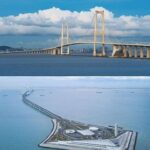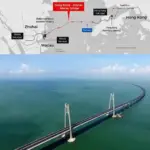The San Francisco-Oakland Bay Bridge, commonly known as the Bay Bridge, stands as a testament to human ingenuity and a vital artery connecting the cities of San Francisco and Oakland across the picturesque San Francisco Bay. Spanning approximately 7 kilometers (4.5 miles), this monumental structure comprises two major sections: a western suspension span and an eastern self-anchored suspension span, both designed to endure the seismic challenges characteristic of the region.

Historical Context and Construction
The concept of a bridge traversing the San Francisco Bay dates back to the mid-19th century, with serious proposals emerging during the California Gold Rush era. However, it wasn’t until the early 20th century that the project gained momentum. Construction commenced on July 9, 1933, under the supervision of Chief Engineer Charles H. Purcell and a distinguished Board of Engineers, including Leon Moisseiff, Ralph Modjeski, Daniel Moran, Charles H. Derleth Jr., and Henry J. Brunnier. The project was a monumental undertaking, requiring innovative engineering solutions to address the deep waters and challenging geology of the bay. The bridge officially opened to traffic on November 12, 1936, marking a significant milestone in American civil engineering.
Design and Structural Features
The Bay Bridge is a two-deck structure, with the upper deck originally carrying automobile traffic and the lower deck accommodating trucks and trains. The western span, connecting San Francisco to Yerba Buena Island, features a double suspension design, while the eastern span, extending from Yerba Buena Island to Oakland, was initially constructed as a cantilever bridge. In response to seismic vulnerabilities highlighted by the 1989 Loma Prieta earthquake, the eastern span underwent a comprehensive redesign and reconstruction, culminating in the completion of a self-anchored suspension bridge in 2013. This new design not only enhances seismic resilience but also contributes to the bridge’s aesthetic appeal.
Cultural Significance and Aesthetic Enhancements
Beyond its functional role, the Bay Bridge has evolved into a cultural landmark. In 2013, artist Leo Villareal introduced “The Bay Lights,” an expansive LED light installation adorning the western span. Comprising 25,000 individually programmed white LEDs, the installation creates dynamic patterns that have transformed the bridge into a nighttime visual spectacle, reflecting the vibrancy of the Bay Area. Originally intended as a temporary exhibit, the overwhelming public appreciation led to efforts to make the installation permanent, further cementing the bridge’s status as an iconic feature of the San Francisco skyline.
Traffic and Transportation Role
As a critical component of the region’s transportation infrastructure, the Bay Bridge accommodates a substantial volume of daily traffic. It is often referred to as the “workhorse” bridge of the Bay Area, carrying more than a third of the traffic of all state-owned bridges combined. The bridge’s capacity and strategic importance necessitate ongoing maintenance and upgrades to ensure safety and efficiency for the thousands of commuters who rely on it daily.
Metropolitan Transportation Commission
Recent Developments and Future Prospects
In recent years, the Bay Bridge has been the focus of several significant developments:
Like Us on Facebook!
- Toll Adjustments: As of January 2025, tolls for the Bay Bridge and other state-owned bridges in the Bay Area have increased by $1, raising the standard toll to $8. This adjustment is part of a broader plan to address transportation funding needs and infrastructure improvements across the region. ABC7 News
- Traffic Incidents: The bridge has experienced various traffic-related incidents, including accidents and protests that have temporarily disrupted the flow of vehicles. For instance, in November 2023, pro-Palestinian protesters blocked westbound lanes, leading to significant traffic delays and subsequent arrests. Such events highlight the bridge’s prominence as a focal point for regional activities and the challenges in maintaining uninterrupted transportation services. Wikipedia
- Seismic Upgrades: Ongoing efforts to enhance the bridge’s seismic resilience continue, with scheduled overnight lane closures through May 2025 to facilitate necessary maintenance and upgrades. These measures aim to ensure the bridge’s structural integrity in the event of future seismic activity, safeguarding the millions of users who traverse it annually. 511.org Homepage
Conclusion
The San Francisco-Oakland Bay Bridge stands as a monumental achievement in civil engineering, embodying both the historical evolution and the dynamic spirit of the Bay Area. Its blend of functionality, aesthetic appeal, and cultural significance continues to inspire and facilitate the region’s growth and connectivity. As the bridge approaches its 90th anniversary, ongoing developments and enhancements ensure that it will remain a vital and cherished landmark for generations to come.






















